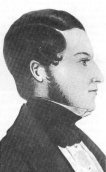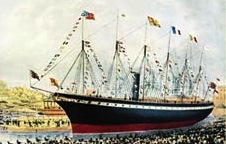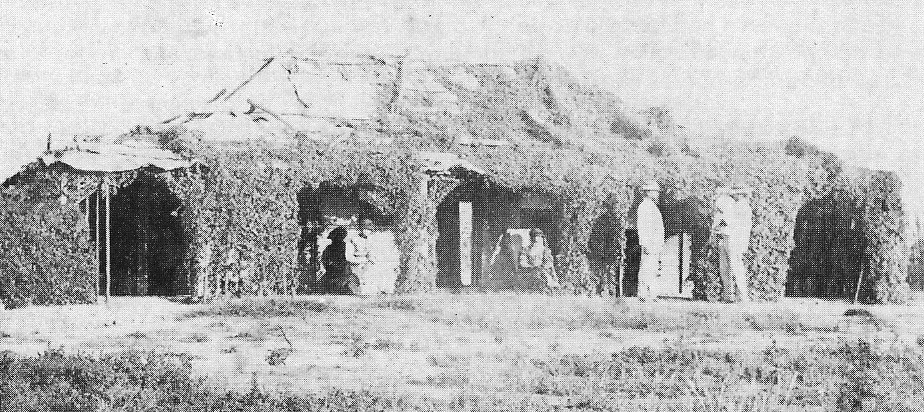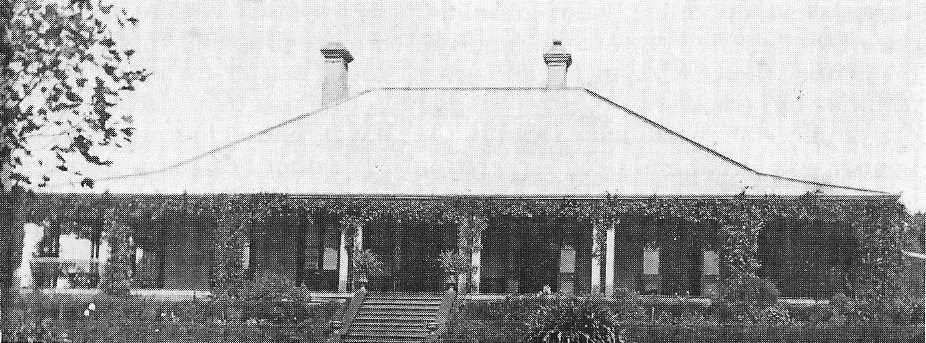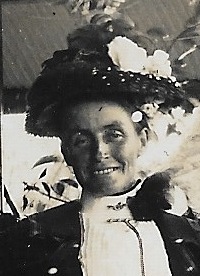Donald was born on the island of Jersey.
Donald started, like others in his family, a study in medicine.
But his uncle, "Donald Charles Cameron of the West Indies",
a bachelor, suggested his nephew come to Guiana to manage the estates
(located in the area of the Berbice river)
and he would then (eventually) inherit his uncles possessions.
Donald is said to have managed the estates with great success.
[Most information given on Donald and Margaret has been derived from MCR.]
Margaret was born on St Eustatius, West Indies. Her father was Peter Moore, son of a Dutch-Irish family of merchants in Berbice.
|
In 1815, the United Kingdom acquired by treaty part of Guiana (the colonies Demerara, Berbice and Essequibo) from the Dutch. The Berbice river is in the western part of the then Dutch colony Surinam. The Dutch had, in the late 17th century, invited British people to develop plantations in the western part of Guiana region.
|
|
|
Donald and Margaret married in 1844 in Berbice.
They lived there some 5 years.
From MCR (p.9), an interview with Elizabeth Patricia:
Uncle Donald had bought "Barcaldine castle"
in the county Argyl, Scotland.
His nephew and family often stayed there.
Uncle Donald had, in the mean time, married and had heirs of his own
and the promise of inheriting became void.
Donald did not want his family to grow up in the West Indies
and Margaret did not like Berbice so she was glad that
they moved to Scotland in 1849 to "Leanassie", Kintail,
the farm his old father John still leased.
Donald was now very much attracted by reports of pastoral successes in
Victoria in Australia.
Donalds mother had already died.
John was willing that his son should go to Australia to see what
prospect there was of making a good home there, but was anxious that
his wife and children should stay with him at Leanassie
till a suitable home had been provided in Australia.
|
|
In 1852, Donald left for Australia to make a living there. As soon as father John died in 1853 at Leanassie, creditors of the owners came to seize the house. So Margaret set out at once to Australia with her children and nurses (and her brother in law Angus) arriving in Melbourne on the S.S. Great Britain (see painting), on 16th October 1853, a trip of just a month. During the voyage, two of the children, Adele and Eliza, died (MCR p.13) and were buried at Cape Verde. [Margaret kept some dirt from the grave in a handkerchief; it was found back in her house when Margaret was 99 and buried with her in her grave in Australia.] Donald could come to the ships arrival to meet his family, but two girls were missing, very sad.
Children: in Berbice (Brit. Guiana): 1845 Isabella Harriet, 1847 John, 1848 Adelaide Elizabeth (+1853 at sea); in Scotland: 1850 Margaret Ann, 1852 Eliza (+1853 Cape Verde). Then in Australia, in Native Creek Station (Victoria): June 1854 Jane (+1854), 1855 Elizabeth Patricia; in Victoria: 1857 Donald Charles Kennedy, 1859 Adele Serenette, 1861 William Henry Moore.
Donalds original investment had prospered and the family now lived at Native Creek, Victoria, for several years. Daughter Elizabeth wrote in her reminescenses (extracted from MCR p.15): The house and gardens at Native Creek were large and well kept. The farm had plenty of people employed. But investors were jittery and in the late 1850s the whole land settlement system faltered. Donald and family had to give up the farm.
Donald now took an office job. Around 1860 he met an old Scottish aquaintence who had explored the interior and who had discovered good land for pasture up north, in the just formed province of Queensland. But initial investments were high, the land was remote and thus lacked ways to transport out the products (animals and wool) and the Aboriginals were said to be dangerous. So the big question was: "Ways and means". Up there, only farms on large "runs" were regarded to be able to become successful. And starting with hired people would be extra risky. But a young Scot, named James Crombie, had started courting Donalds daughter Isabella....
James Crombie had already been a successful farmer in Victoria, together with
his 6 years younger brother William.
So Donald and his still teenage son John teamed up with the Crombies.
They managed to get the funds and with the equipment and animals
the men would set out to the north to start the farm.
Margaret proposed, for the time the men would set up the farm,
to create her own income by starting a school.
Donald was aghast, for a married woman did not do such things.
|
|
In 1862, Donald and son John together with two other men, James and William Crombie, set out (with a flock of sheep) into the interior to the good land for pasture.
|
|
Any produce to be sold had to be transported to Rockhampton (at the Queensland coast, some 600 km N of Brisbane), a town with a railroad station. The Crombies settled nearby.
In 1866 Donald felt Margaret and her 4 daughters and two younger sons could come too, and he went to Sydney to get them. They travelled to Rockhampton by steamer, where John waited with waggons to go to Barcaldine.
|
By 1869 (MCR p.32), the family was again in financial difficulty. The past years had been very dry, the wool prices had fallen dramatically, wages had risen and beef had to be sold to the boiling down works. They were forced to enter a dubious financial deal with the creditor, Mr Mort and associates, in which they became part owner while the Camerons got wages only against their share in the profits (if there were any). Now the Camerons moved to "Home Creek" while the Crombies stayed on "Barcaldine".
Donalds health deteriorated. Was it due to all the strain? Or did the very wet season of 1870 take its toll? He died in his home, October 1872, and was buried on the property. The acre of land around the grave was made a freehold (MCR p.40).
On the children:
Isabella Harriet married James Crombie in 1869.
Margaret Ann married William Crombie in 1874.
Margaret died in 1885; their children then were taken in by Isabella
who lived with James in Brisbane. William died in 1898.
Elizabeth Patricia married William J. Beauchamp Cameron in 1881,
Donald married Ada (Ada died in 1885),
Adele married Tom Sword
and William (who became a politician) married Amy Maria Hassell.
|
Pioneer settlers in Western Queensland passed through trials, hardships, and anxieties which in these days of railways, motor cars and telephones it is almost impossible to realise. Everything to be done had to be done by themselves - blacksmith, stonemason, carpenter, saddler, farrier, fencer, builder, painter, &c., were beyond reach, and all such work had to be undertaken by the pioneers. In those days lines of demarcation were unknown. There was no coach, no regular mail, no school, no doctor, no church. Teams bringing goods from Rockhampton, and sometimes Brisbane, were as long as five months on the road. Wool was of so little value that after shearing, carriage to Rockhampton, steam freight to Sydney, together with commission and charges, were deducted, there was little, if anything, in the way of cash surplus for the grower. Sheep were unsaleable, while the financial position was appalling. Flood, fire, drought, sickness, fever and ague, and serious accidents sometimes terminating fatally, had to be met and fought. John Cameron found refuge for days up a gum tree in a Dawson River flood, and finally was saved by James Crombie, who swam miles to effect the rescue of his friend. Bush fires came in from the far West, and devastated the country from the Diamantina to the Aramac, and fresh pastures were then to be sought unless, as sometimes happened, heavy rain followed closely in the track of the fire. A drought year meant moving the stock in patriarchal style. Sickness and accidents were treated on the station, and many lives were saved by the good nursing and attention of the pioneer women of the West. In the case of severe accidents, such as the fracturing of an arm or a leg, splints were made upon the spot, and applied by the owner of the station, and although this amateur treatment might result occasionally in a shortened limb, it was generally successful and enabled the patient to return to his usual bush occupation. (From the obituary of MAM Cameron, Brisbane Courier, 27 July 1918, p.12). |
"It is 1874. There is a boom in the grazing industry.
The gold-miners on the Palmer want beef and mutton
and world wool prices have gone up.
Sheep can now be left on large tracts surrounded by netting.
And wool is now washed by machinery.
Thus all who made it through the hungry years
are suddenly rich (MCR p.48)".
This provided the opportunity to buy themselves out of the contract.
It succeeded, and they were (sort of) rich.
But it must have been hard to part with their self-developed properties.
All now travelled down to Brisbane.
Although the winding down of the financial affairs took until 1877.
Then, under the leadership of John, the Camerons and Crombies bought
"Green Hills" and "Kensinton Downs" in 1879.
They ran these (almost adjacent) properties together but after four
years the partership was dissolved.
John took, on behalf of the entire Cameron family, "Kensington Downs".
Margaret had her own large share.
Kensington was a fine property situated on the banks of the Thompson
about 25 miles from Muttaburra.
MCR p.54: Margaret set off November 1877 on a voyage to England with most of the family. In particular the younger daughters should see more of the world (notably Elizabeth, who had fallen in love with "the wild Irishman", Beauchamp Cameron). John remained behind to manage the farms. The voyage included Brindisi, over land to London (to see all there was to see), then Scotland with excursions and back to London. In 1878 they went to Paris for the World Exhibition to then come back to London. They returned in Australia early 1879.
It conspired that several of the children moved to Brisbane.
Johns wife Anna suffered from consumption and lived in
the mountain town Toowoomba (at its base was a swampy area,
called Toowoomba = "plenty water sit down",
while John (later Sir John) lived in Brisbane
(where he had a governmental function).
Her house was called "Dawnie" after the Cameron-clan lineage.
After she died, Isabella also took care of Johns children
(in addition to her own she also cared for those of Margaret).
Isabella had a big house in Brisbane, and servants, of course.
Isabella and James as well as Tom and Adele (who also lived in
Brisbane) rented every summer a house in Toowoomba,
to flee the heat of Brisbane.
But Toowoomba became the focal point of the family.
Elizabeth and Beauchamp would move in 1889, from their farm in Quiplie.
They built a town home in Toowoomba,
called "Lundavra"
(after Beauchamps ancestral valley in Scotland;
also Elizabeths grandfather had lived there).
Around it Beauchamp developed a terraced garden,
the terrace aspect copied from what he had seen on Java.
It had an orchard in which was a tree of "Royal George' peaches",
which were delicious and became known in the family as
Lundavra-peaches (MCR p.75-78).
|
|
In those years, all family members were well to do and had a wonderful life-style. Since Margaret had grown up amongst wealth, she understood how to handle it when she had it again. She understood the art of gracious living, and lived like an "old money" rather than a "new money" person. And the three Toowoomba houses Fairholme, Lundavra and Dawnie were all within walking distance of each other (MCR p.79). But Margaret kept a coach, brand name Victoria, and a coachman to run the family around.
Helen, one of the daughters of Beauchamp and Elizabeth, described her grandmother Margaret as follows (MCR p.82). It is very hard to describe her. She was such a strong personality in her own right, and yet so comfortable to her times. Except for a few stabilizing years in Scotland, she had always lived on the outskirts of Empire. She had had to face life. "Only those who brave its dangers comprehend its mystery!" Perhaps her very magnitude isolated her. She seemed larger than life. To us, and I think to most people who met her, she had no equal. Her regal bearing, beautiful voice and exquisite dress made her remarkable. She was dependable and predictable. Now and them some extra gentleness took us by surprise. It was in her garden that I met my first swing, and loved it so energetically that I blistered my babyisch hands. Next day I found the wire ropes padded, each stitch firmly and neatly placed. I doubt if I ever dared to thank her! And she adds that Sundays were holy at Fairholme, church and no work or play, it was a bore...
In 1885, Margarets mother Adele Moore had died in London. Margarets sister Patricia (Tishie), who had cared for her mother, now came to Australia. Helen Cameron, daughter of Beauchamp and Elizabeth, recounts (MCR p.80): "When I was little, I thought she was a witch. She had endless misfortunes. One hand was almost useless, because the sinews of her right arm were accidentally cut in an operation. The fingers were so cramped that when she was old and bedridden, we had to pack her nails with cotton and wool to keep them from cutting her palm. Yet she never stopped knitting (not wool, linen lace!) and sewed exquisitly. One eye was quite blind, and the sight of the other half had been only partially restored by operation for cataract. She was indominable!" Tishie stayed with several family members but finally was living at "Aughamore", the farm of Beauchamp and Elizabeth (she being her god-child) where she died in 1922, at the age of close to 100 (her sister Margaret died at 99).
|
|
In 1893, Margaret had a stroke.
Was it because of all the worries that were around?
She fell to the floor after reading a telegram from son Willie, out west,
announcing some disaster.
She went into a deep coma, returning occasionally.
But at one point she seemed so clinically dead that Dr Horn said:
"If I did not know this patient, I would issue a death certificate."
Whenever she was conscious, she would ask after Willie,
who had been held up by the floods in west Queensland.
She pulled through and lived another 16 years,
albeit had become frail (MCR p.93).
The sisters now agreed that mother Margaret would never be
without one of them in her home.
This illness led indirectly to her shifting from the Church of England
to the Presbyterian Church.
She had been a regular church goer and a generous subscriber to all appeals,
but she felt very much hurt that the Rector of the church had not
visited her during her illness and so she changed fortwith (MCR p.93).
|
|
Toward the end of her life, Margaret purchased a motor car. It was one of the first in Toowoomba. But neither the coachman nor the groom could master the art of driving it.
Andrew Crombie writes in the 1918 obituary for Margaret about her years at Fairholme: After living an ordinary lifetime in the bush Mrs Cameron acquired, in 1887, a very beautiful property named Fairholme, on the Toowoomba Range. Here she resided for some 30 years, happy in the possession of the love and respect of all the members of her numerous family. Retaining her full mental powers to the last, she took the liveliest interest in their affairs, and much of their success in life may be attributed to her wise counsels and influence for good. She passed away quietly on March 8 last, in her 99th year, attended by her three daughters and one son, they being the sole surviving members of the party which comprised the pioneers of the Barcoo in 1866.
The year before, in 1917, she had sold Fairholme to the Presbytarian Ladies College for the establishment of "Fairholme College".
MCR: Margaret Reeves née Cameron,
great-granddaughter of DCC and MAM;
most of the "stories" were taken from her book
"A Strange Bird on the Lagoon"
(1985, Boolarong Publications; ISBN 0908175 957).
Photos from MCR have been reproduced with permission
of the Cameron descendants.
pAJnS: Photoarchive of Aprilla Jacometti née Stanford,
granddaughter of Margarets granddaughter Meta.
Data on births, marriages and deaths of the Cameron branch have
originally been taken from
AncestryResearchService
The Moore ancestry has been taken from
Sewell genealogy
and the Cameron website.
Crombie, A., 1918. "Cameron, Margaret Anne (1819-1918)", Obituaries Australia, National Centre of Biography, Australian National University, http://oa.anu.edu.au/obituary/cameron-margaret-anne-14604/text25734
To enlarged photos.
Back to the genealogy of DCC and MAM.

